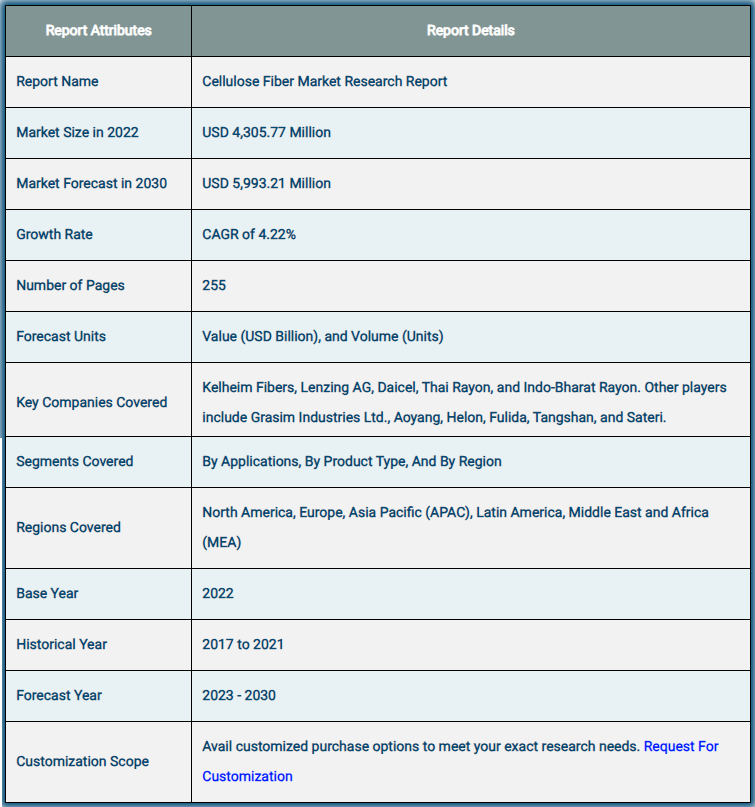Cellulose Fiber Market Size, Share, Industry Analysis, Trends, Growth, Forecasts, (2024–2032)

It is estimated that the size of the global market for cellulose fibres was around USD 4,305.77 million in 2022 and would increase to approximately USD 5,993.21 million by 2030, with a compound annual growth rate (CAGR) of approximately 4.22% between 2023 and 2030.
✈👉Get a Free Sample: 🚀https://www.zionmarketresearch.com/sample/cellulose-fiber-market
Introduction
The cellulose fiber market is experiencing significant growth, driven by increasing demand for sustainable and eco-friendly materials across various industries. Cellulose fibers, derived from plant sources such as wood pulp, cotton, and hemp, are biodegradable and renewable, making them an attractive alternative to synthetic fibers. With the rising awareness of environmental issues and the need for sustainable production processes, the cellulose fiber market is poised for expansion in the coming years.
This article provides a comprehensive overview of the cellulose fiber market, exploring key trends, growth drivers, challenges, and future projections.

Overview of the Global Cellulose Fibre Market
Cellulose fibers are natural fibers composed primarily of cellulose, a polymer that constitutes the structural component of plant cell walls. These fibers are widely used in textiles, paper, packaging, and other industrial applications. The increasing preference for sustainable products has led to a growing market for cellulose fibers.
Esters, or ethers of cellulose, make up cellulose fibres. These are typically derived from wood, bark, plant leaves, and other plant-based materials. These fibres consist of hemicelluloses and lignin. Different proportions of these chemicals give certain fibres their unique mechanical characteristics.

The textile industry uses cellulose fibres mostly for apparel. Nonetheless, it finds usage in several applications such polymer composites, chemical filters, biocomposites, and fibre reinforcement composites. Among the main uses for cellulose fibres are in clothes, textiles, and spun yarn.
Global Market for Cellulose Fibre: Growth Drivers
Future expansion in the global cellulose fibre market could be aided by the textile industry’s growing need for cellulose fibres. Furthermore, due to its attributes such being environmentally friendly, skin-friendly, and biodegradable, the market is anticipated to develop in the next years.
The global cellulose fibre market is driven by the middle class’s increasing disposable income. Furthermore, the global market may be impacted by the textile industries’ substantial consumption. The primary raw material required to produce cellulose fibres, another significant factor driving the global market, is wood pulp. On the other hand, the increasing number of new competitors joining the global cellulose fibre market could favourably impact it. On the other hand, stepping up government efforts to save the world’s forests could somewhat impede its expansion.
✈👉Directly Purchase a copy of the report with TOC: 🚀https://www.zionmarketresearch.com/toc/cellulose-fiber-market
worldwide market for cellulose fibre: report scope

Segmentation of the Global Cellulose Fibre Market
The market for cellulose fibre is segmented globally according to applications, including industrial, textile, hygienic, and others. Global market segmentation is based on product type, with synthetic and natural categories. Moreover, the geographical division is provided by North America, Europe, Asia-Pacific, Latin America, and the Middle East & Africa.
Global Market for Cellulose Fibre: Regional Evaluation
In the global market for cellulose fibres, Asia-Pacific held the most market share. The global market is driven by the increasing demand in this area for garment applications. Asia Pacific is divided into many smaller markets, including those in China, India, and Japan. Europe is following this trend as a result of consumers’ growing spending power, which is further impacting the worldwide market.
Additionally, North America develops as a significant cellulose fibre production base; this is expected to drive the expansion of the global market. This region’s worldwide cellulose fibre market is predicted to grow as major players concentrate on introducing new, high-quality goods to the market through partnerships, mergers, and acquisitions.
Market Size and Growth
The global cellulose fiber market was valued at approximately USD 36 billion in 2023 and is projected to reach USD 55 billion by 2028, growing at a CAGR of 8.5% during the forecast period. Key factors contributing to this growth include:
- Growing demand for sustainable textiles: The fashion industry is increasingly focusing on sustainability, leading to a rise in the use of cellulose fibers in apparel and home textiles.
- Expansion of the packaging industry: The shift towards eco-friendly packaging materials is boosting demand for cellulose fibers in the packaging sector.
- Technological advancements: Innovations in fiber production and processing technologies are enhancing the quality and application of cellulose fibers.
Key Market Segments
By Type
- Viscose Fiber: Also known as rayon, viscose fiber is derived from wood pulp and is widely used in textiles and apparel.
- Lyocell Fiber: A more sustainable alternative to viscose, lyocell is produced using a closed-loop process that recycles solvents, making it eco-friendly.
- Modal Fiber: A type of rayon made from beech tree pulp, modal fiber is known for its softness and is commonly used in clothing and home textiles.
- Other Cellulose Fibers: This includes fibers derived from cotton, hemp, and other plant materials.
By Application
- Textiles: The largest segment, encompassing apparel, home textiles, and non-woven fabrics.
- Paper & Packaging: Cellulose fibers are essential in producing paper products and sustainable packaging solutions.
- Medical and Hygiene Products: Used in products such as surgical gowns, masks, and feminine hygiene items due to their absorbent and biodegradable properties.
- Others: Includes applications in automotive interiors, insulation, and construction materials.
By Region
- North America: Significant market growth driven by increasing demand for sustainable textiles and eco-friendly products.
- Europe: A leading market for cellulose fibers, supported by stringent regulations promoting sustainability and eco-friendly materials.
- Asia-Pacific: Fastest-growing region due to rising textile production and consumption, particularly in countries like China and India.
- Latin America and Middle East & Africa: Steady growth with increasing investments in sustainable fiber production and textile manufacturing.
Market Dynamics
Drivers
- Sustainability Trends: Growing consumer awareness and demand for eco-friendly products are driving the shift toward cellulose fibers, which are biodegradable and sourced from renewable materials.
- Fashion Industry Innovations: The fashion industry is embracing sustainability, leading to increased usage of cellulose fibers in clothing, which are often marketed as more environmentally friendly compared to synthetic fibers.
- Expansion of Biodegradable Packaging: With rising concerns over plastic pollution, the demand for biodegradable packaging materials made from cellulose fibers is increasing.
- Government Regulations: Policies promoting sustainable practices and materials in various countries are encouraging manufacturers to adopt cellulose fibers.
Challenges
- Price Volatility: The price of raw materials, such as wood pulp and cotton, can be volatile, affecting the overall cost of cellulose fibers and impacting market stability.
- Competition from Synthetic Fibers: While cellulose fibers are gaining popularity, they face competition from cost-effective synthetic fibers that dominate the textile industry.
- Production Challenges: The manufacturing processes for cellulose fibers, especially lyocell, can be complex and require significant investment in technology and equipment.
Emerging Trends
- Circular Economy Initiatives: The focus on a circular economy is leading to the development of processes that recycle cellulose fibers and reduce waste, making them more sustainable.
- Smart Textiles: Innovations in smart textiles that incorporate cellulose fibers with advanced functionalities, such as moisture management and temperature control, are gaining traction.
- Eco-Friendly Innovations: Companies are investing in R&D to develop more sustainable production processes, such as closed-loop systems that minimize waste and environmental impact.
- Consumer Demand for Transparency: Consumers are increasingly seeking transparency regarding the sustainability of products, driving companies to disclose sourcing and production practices.
Future Outlook
The cellulose fiber market is expected to continue its growth trajectory, driven by the rising demand for sustainable products across various industries, particularly textiles and packaging. As manufacturers invest in innovation and sustainability, the market is likely to see the introduction of new cellulose fiber products that meet consumer demands for eco-friendly materials.
Additionally, the growing emphasis on circular economy practices and biodegradable solutions will further enhance the appeal of cellulose fibers in a world increasingly focused on sustainability.
Conclusion
The cellulose fiber market is positioned for significant growth as industries move towards more sustainable practices and consumers demand eco-friendly products. With rising awareness of environmental issues and ongoing technological advancements, cellulose fibers are set to become a key component of the future textile and packaging landscapes. Companies that prioritize sustainability and innovation will be well-equipped to thrive in this dynamic market environment.
✈👉Enquiry for buying: 🚀https://www.zionmarketresearch.com/inquiry/cellulose-fiber-market
Get to know better
Anti-counterfeit Packaging Market
On-board Diagnostics (OBD) AfterMarket
Sodium Cocoyl Glycinate Market
📞Contact Us:
Zion Market Research212
USA/Canada Toll Free: 1 (855) 465–4651
Newark: 1 (302) 444–016611\
📲Web: https://www.zionmarketresearch.com/
👉Blog: https://zmrblog.com/

Comments
Post a Comment